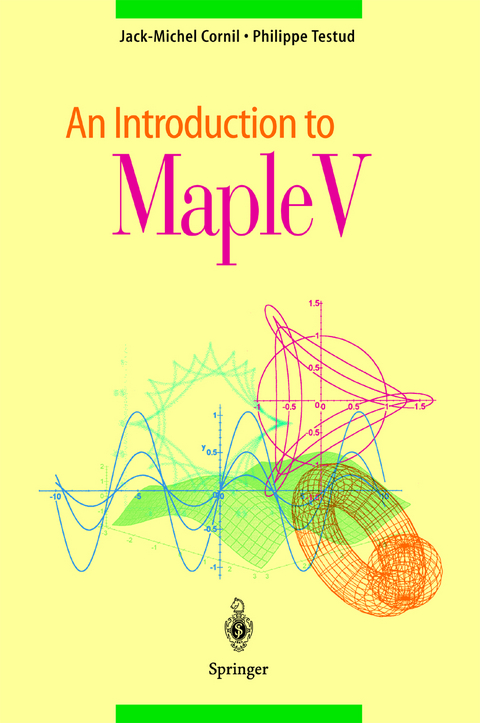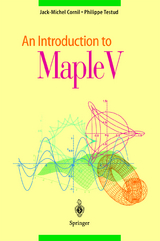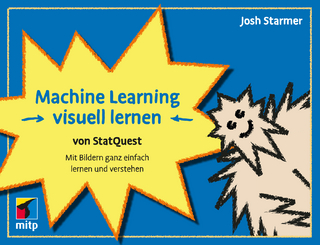An Introduction to Maple V
Springer Berlin (Verlag)
978-3-540-66442-0 (ISBN)
1. What MAPLE Can Do for You.- 1.1 Arithmetic.- 1.2 Numerical Computations.- 1.3 Polynomials and Rational Functions.- 1.4 Trigonometry.- 1.5 Differentiation.- 1.6 Truncated Series Expansions.- 1.7 Differential Equations and Systems.- 1.8 Integration.- 1.9 Plot of Curves.- 1.10 Plot of Surfaces.- 1.11 Linear Algebra.- 2. Introduction.- 2.1 First Steps.- 2.2 Assignment and Evaluation.- 2.3.1 Fundamental Operations.- 2.4 First Approach to Functions.- 2.5 Simplification of Power Functions.- 3. Arithmetic.- 3.1 Divisibility.- 3.2 Diophantian Equations.- 4. Real Numbers, Complex Numbers.- 4.1 The Real Numbers.- 4.2 The Complex Numbers.- 5.1 Curves Defined by an Equation y = f (x).- 5.2 The Environment of plot.- 5.3 Parametrized Curves in Cartesian Coordinates.- 5.4 Curves in Polar Coordinates.- 5.5 Curves Defined Implicitly.- 5.6 Polygonal Plots.- 5.7 Mixing Drawings.- 5.8 Animation.- 5.9 Using Logarithmic Scales.- 6. Equations and Inequations.- 6.1 Symbolic Solution: solve.- 6.2 Approximate Solution of Equations: fsolve.- 6.3 Solution of Recurrences: rsolve.- 7. Limits and Derivatives.- 7.1 Limits.- 7.2 Derivatives.- 8. Truncated Series Expansions.- 8.1 The Function series.- 8.2 Operations on Truncated Series Expansions.- 8.3 Series Expansion of an Implicit Function.- 9. Differential Equations.- 9.1 Methods for Solving Exactly.- 9.2 Methods for Approximate Solutions.- 9.3 Methods to Solve Graphically.- 10. Integration and Summation.- 10.1 Integration.- 10.2 Operations on Unevaluated Integrals.- 10.3 Discrete Summation.- 11. Three-Dimensional Graphics.- 11.1 Surfaces Defined by an Equation z = f (x, y).- 11.2 The Environment of plot3d.- 11.3 Surface Patches Parametrized in Cartesian Coordinates.- 11.4 Surfaces Patches Parametrized in Cylindrical Coordinates.- 11.5 Surface Patches Parametrized in Spherical Coordinates.- 11.6 Parametrized Space Curves.- 11.7 Surfaces Defined Implicitly.- 11.8 Mixing Plots from Different Origins.- 12. Polynomials with Rational Coefficients.- 12.1 Writing Polynomials.- 12.2 Coefficients of a Polynomial.- 12.3 Divisibility.- 12.4 Computation of the g.c.d. and the I.c.m.- 12.5 Factorization.- 13. Polynomials with Irrational Coefficients.- 13.1 Algebraic Extensions of ?.- 13.2 Computation Over an Algebraic Extension.- 13.3 Polynomials with Coefficients in ?/p?.- 14. Rational Functions.- 14.1 Writing of the Rational Functions.- 14.2 Factorization of the Rational Functions.- 14.3 Partial Fraction Decomposition.- 14.4 Continued Fraction Series Expansions.- 15. Construction of Vectors and of Matrices.- 15.1 The linalg Library.- 15.2 Vectors.- 15.3 Matrices.- 15.4 Problems of Evaluation.- 15.5 Special Matrices.- 15.6 Random Vectors and Matrices.- 15.7 Functions to Extract Matrices.- 15.8 Constructors of Matrices.- 16. Vector Analysis and Matrix Calculus.- 16.1 Operations upon Vectors and Matrices.- 16.2 Basis of a Vector Subspace.- 17. Systems of Linear Equations.- 17.1 Solution of a Linear System.- 17.2 The Pivot's Method.- 18. Normalization of Matrices.- 18.1 Determinant, Characteristic Polynomial.- 18.2 Eigenvalues and Eigenvectors of a Matrix.- 19. Orthogonality.- 19.1 Euclidean and Hermitean Vector Spaces.- 19.2 Orthogonal Polynomials.- 20. Vector Analysis.- 20.1 Jacobian Matrix, Divergence.- 20.2 Gradient, Laplacian, Curl.- 20.3 Scalar Potential, Vector Potential.- 21. The MAPLE Objects.- 21.1 Basic Expressions.- 21.2 Real and Complex Numerical Values.- 21.3 Expression Sequences.- 21.4 Ranges.- 21.5 Sets and Lists.- 21.6 Unevaluated Integrals.- 21.7 Polynomials.- 21.8 Truncated Series Expansions.- 21.9Boolean Relations.- 21.10 Tables and Arrays.- 22. Working More Cleverly with the Subexpressions.- 22.1 The Substitution Functions.- 22.2 The Function map.- 23. Programming: Loops and Branches.- 23.1 Loops.- 23.2 Branches.- 24. Programming: Functions and Procedures.- 24.1 Functions.- 24.2 Procedures.- 24.3 About Passing Parameters.- 24.4 Follow-up of the Execution of a Procedure.- 24.5 Save and Reread a Procedure.- 25. The Mathematical Functions.- 25.1 Catalogue of Mathematical Functions.- 25.2 How Does a MAPLE Function Work?.- 26. Maple Environment in Windows.- 26.1 The MAPLE Worksheet.- 26.2 The File Menu.- 26.3 The Edit Menu.- 26.4 The View Menu.- 26.5 The Insert Menu.- 26.6 The Format Menu.- 26.7 The Options Menu.- 26.8 The Window Menu.- 26.9 On-line Help.
"I do not like manuals. ... I prefer introductions like this one: After some unavoidable preliminaries, numerous examples (arranged by topic, not by command name) show how Maple can be used to solve problems, and (very important!) also what one can do wrong. Normally, these samples can easily be modified, and will (after some trial and error, maybe) soon lead to a solution of one's problem. - Those who think like me will find this book very helpful."
P.Schmitt, Monatshefte für Mathematik, Vol. 141, Issue 1, 2004
"... Thus the book is designed for students, teachers, engineers and researchers aiming to master the Maple computer algebra system at an introductory level. The book achieves this aim. The coverage of material is quite extensive. ... I worked through selected parts of the book attempting to view the instructions from a beginner's perspective. The instructions are clear and the examples are relevant for most of the mathematics covered at undergraduate level by engineers and scientists. There are adequate warnings along the way as to where things might go wrong. This feature is a particularly useful aid to the beginner. I believe I would have found this book very helpful when I first started using Maple. ... The structure of the book allows the beginner to locate easily practical helpful information to deal with the problem at hand. ... ...I would recommend that some copies be placed in your computer laboratory to be on hand when students are working alone, as I am sure they will find it most helpful."
Australian Mathematical Gazette, Volume 29, Number 1
"[...] There are several ways to make yourself familiar with a computer algebra system. This book provides a useful and easy way to get acquainted with MAPLE V. This is an excellent book written about MAPLE V. We can recommend this book to mathematicians, physicists, chemists, engineers, and to all who aren't loath to use computer incomputations."
Acta Math.Scient. 68, p. 494, 2002
| Erscheint lt. Verlag | 6.6.2001 |
|---|---|
| Übersetzer | T. van Effelterre |
| Zusatzinfo | XX, 470 p. 37 illus. |
| Verlagsort | Berlin |
| Sprache | englisch |
| Maße | 155 x 235 mm |
| Gewicht | 732 g |
| Themenwelt | Informatik ► Theorie / Studium ► Algorithmen |
| Mathematik / Informatik ► Mathematik ► Allgemeines / Lexika | |
| Mathematik / Informatik ► Mathematik ► Analysis | |
| Mathematik / Informatik ► Mathematik ► Angewandte Mathematik | |
| Mathematik / Informatik ► Mathematik ► Wahrscheinlichkeit / Kombinatorik | |
| Schlagworte | algorithms • Computation • Computer Algebra • Derivative • Maple • Maple (Programm) • Mathematica • Mathematics • programming • Recursion • scientific tools • Symbolic Computation |
| ISBN-10 | 3-540-66442-4 / 3540664424 |
| ISBN-13 | 978-3-540-66442-0 / 9783540664420 |
| Zustand | Neuware |
| Haben Sie eine Frage zum Produkt? |
aus dem Bereich




